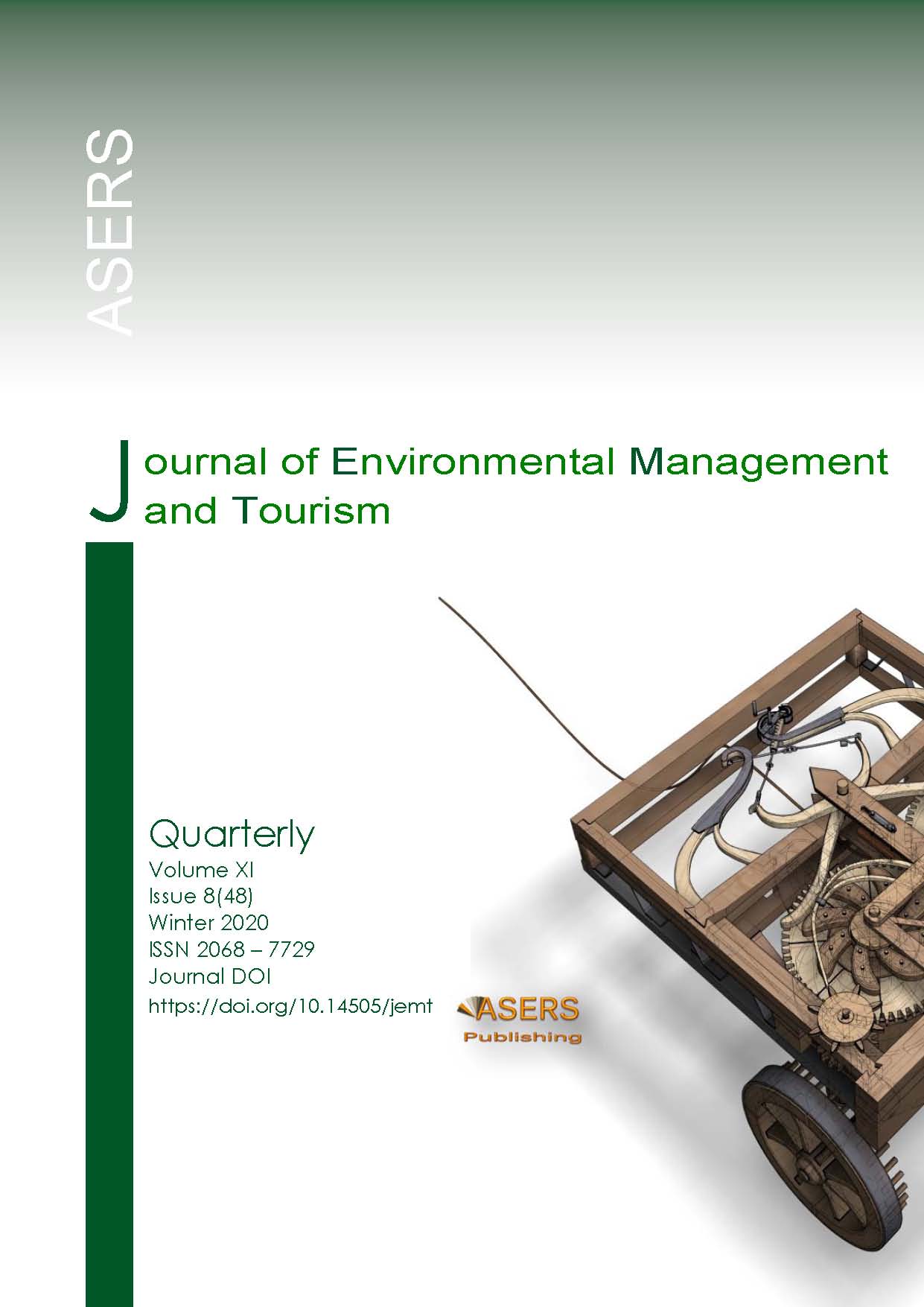Sustainable Risk Management and Rural Tourism as a Development and Strategic Factor of the Reventador Parish - Ecuador
Abstract
The study is based on the approach proposed by the World Tourism Organization when it emphasizes the value of the tourism sector as an essential activity of modern societies and a determining factor in the quality of life. To this end, this research emphasizes government intervention in environmental, risk and tourism issues, thus preserving the sustainable development of the regions. The method of scientific study is used. Among the results, environmental safety is highlighted as one of the fundamental rights of society and an indispensable requirement for the competitiveness and sustainability of tourism". The great emergency that exists in Ecuador in the "application of public policies of tourist security for the consolidation of the process of regional integration". It is concluded that an integral and systemic approach to social development must be considered, one that links the environmental, economic, productive, socio-cultural, tourism, and institutional dimensions in an insertable manner. Taking advantage of the spaces and channels of community participation with the tourist destinations of the area.
References
[2] Granovetter, M. 2011. The Sociology of Economic Life, Routledge.
[3] Herrera, M. R. G., and Rodríguez, M. de los Ángeles R. 2016. Gestión Sustentable De Riesgos Y Crisis En El Turismo Mexicano Y Latinoamericano Como Problema Estratégico Para La Seguridad De Los Destinos. Implicaciones Para Ciudad Juárez, México. European Scientific Journal, ESJ 12(11): 183. DOI:https://doi.org/10.19044/esj.2016.v12n11p183
[4] Keller, E. and Blodgett, R. 2007. Riesgos naturales: procesos de la Tierra como riesgos, desastres y catástrofes. Pearson Education.
[5] Morales, N. and Gómez, G. 2020. Identification of the tourist’s perception towards the destination Cuenca-Ecuador, through “Netnography”. Retos, 10(19). DOI: https://doi.org/10.17163/ret.n19.2020.05
[6] Mullo, E. and Padilla, M. 2018. Cultural diversity and its impact on community tourism of Andean region. Siembra, 6(1). Available at: https://revistadigital.uce.edu.ec/index.php/SIEMBRA/article/view/1707/1673
[7] Reck, G. and Martínez, P. 2017. Áreas protegidas: ¿turismo para la conservación o conservación para el turismo? Polémika, 12(5). Available at: https://revistas.usfq.edu.ec/index.php/polemika/article/download/955/1135/
[8] Reisinger, Y. and Dimanche, F. 2009. International Tourism. Routledge.
[9] Ripoll, V. 2010. Guia metodológica para la evaluación del impacto ambiental. Mundi-Prensa.
[10] Sforzi, F. and Amin, A. 2003. The Institutions of Local Development, Routledge.
[11] Constitution of the Republic of Ecuador. National Assembly, 2008. Available at: https://www.cec-epn.edu.ec/wp-content/uploads/2016/03/Constitucion.pdf
[12] DerechoEcuador. “Official Register Supplement 160 of March 12, 2020,” 2020. Available at: https://www.derechoecuador.com/registro-oficial/2020/03/registro-oficial-no160-jueves-12-de-marzo-del-2020-suplemento
[13] Food and Agriculture Organization of the United Nations, "Food should be a national security issue, 2009," FAO. Available at: http://www.fao.org/news/story/en/item/8967/icode/
[14] GADP El Reventador. “Development and Territorial Ordering Plan,” 2016. Available at: https://gadreventador.gob.ec/wp-content/uploads/2016/03/POA-2014.pdf
[15] GEOLOGÍAWEB, “Deslizamientos de tierra y sus tipos,” 2020. https://geologiaweb.com/deslizamientos/
[16] Geophysical Institute of the National Polytechnic School, IGEPN. “The earthquakes in the north-east of the equator on 5 March 1987”. 2012. Available at: https://www.igepn.edu.ec/servicios/noticias/601-los-terremotos-del-nor-oriente-del-ecuador-del-5-de-marzo-de-1987
[17] Global Sustainable Tourism Council, “Using Standards to Scale Sustainability in Tourism» case study in the One Planet – Sustainable Tourism Programme 2019 Annual Magazine”. Available at: https://www.oneplanetnetwork.org/resource/one-planet-network-2019-annual-magazine
[18] National risk management system, SNGRE, Ecuador, 2020. Available at: https://www.gestionderiesgos.gob.ec/orellana-en-emergencia-por-derrame-petrolero-en-sucumbios/
[19] Plan de Desarrollo y Ordenamiento Territorial (PDOT) 2019. Available at: https://www.planificacion.gob.ec/wp-content/uploads/downloads/2019/08/Folletos-autoridades-provinciales.pdf
[20] Rainforest Alliance. “Estandar de agricultura sostenible de Rainforest Alliance 2020,” 2020. Available at: https://www.rainforest-alliance.org/business/wp-content/uploads/2020/06/Esta%CC%81ndar-de-Agricultura-Sostenible-de-Rainforest-Alliance-2020_Requisitos-Para-Fincas.pdf
[21] Republic of Ecuador, “Supplement to Official Registry N ° 163 of March 17, 2020, decree no. 1017 (state of emergency for public calamity in the whole national territory by cases of covid-19),” 2020. Available at: https://www.finanzas.gob.ec/wp-content/uploads/downloads/2020/04/ANEXO-No.-1-DECRETO-ESTADO-DE-EMERGENCIA-1017-MARZO2020.pdf
[22] Sustainable Tourism & Responsible Travel, “Sustainable Tourism is Wicked, 2017,” Sustainability in the Tourism System. Available at: https://sustainabletourismandresponsibletravel.com/sustainable-tourism-is-complex-and-complicated-it-is-a-wicked-problem/
[23] United Nations. “Declaration of the United Nations Conference on the Human Environment,” 1972. Available at: https://www.ipcc.ch/apps/njlite/srex/njlite_download.php?id=6471
[24] UNOHBITAT Ecuador, “Organic Code of Territorial Ordering, Autonomy and Decentralization,” 2010. Available at: https://urbanlex.unhabitat.org/sites/default/files/codigo_organico_de_organizacion_territorial_autonomiautf-8q_y_descentraliz.pdf
[25] World Tourism Organization, UNWTO. “Tourism Highlights, 2003”, World Tourism Organization, Available at: https://www.e-unwto.org/doi/book/10.18111/9789284406647
Copyright© 2025 The Author(s). Published by ASERS Publishing 2025. This is an open access article distributed under the terms of CC-BY 4.0 license.
